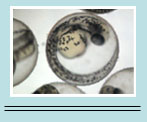

Home
Common Techniques
Classroom Experiments
Virtual Experiments
Tutorials
Games
Glossary
Links
Publishing
Opportunities
About This Site
Contact Us
ZFIN
Cite Us
Standard Operating Procedure
Liang lab, University of Minnesota-Duluth
Conditions
Lights: 14L: 10D timer, On: 8:30 AM Off: 10:30PM,
Room Temp: 76 F Water Temp: 82 F
Animals: Danio rerio (Zebrafish)
Emergency contacts: Names and phone numbers of at least two people
Feeding
Brine Shrimp: Remove air hose from oldest brine shrimp hatchery and let brine settle. Drain hatcher into a cloth to collect brine and expel salt water. Throw away unhatched brine eggs. Rinse the brine with system water and resuspend with system water. Clean out the hatchery using a brush and water only. Fill with system water and two (1/2 tsp) of brine eggs and two 1/4 tsp salt. Replace the air hose. The brine will be ready to use the following day. Feed tanks of 10 adults 1 dense pipette full (about 2 mls), tanks of 20+ 2 dense pipette fulls (about 4 mls). Babies are fed according to the directions posted on each tank.
Flake Food: Mix 1/3 of Tetramin Flake©, 1/3 of OSI Flake© and 1/3 of Freeze-dried bloodworms. Babies are fed this mix, however, it is ground up into a powder before feeding. Use 1/2 teaspoon to feed tanks of 10+ adults and 1 tsp. to feed tanks of 20+ adults. Babies are fed according to the directions posted on each tank.
Paramecium: This is only fed to babies 5 days old to 14 days old. Filter a container full through a cloth and feed the filtrate to the tanks. Look on baby directions (white tag on each baby tank) for specified amounts. Scrub out container with water and a brush. Fill with RO water and a 1/8 tsp of salt. Add about 12 drops of Liquid Fry© along with 50mls of left over paramecium. Put the lid on loosely and place container at the very end of the line.
Frequency: Feed all fish 2-3 times daily. AM feedings are done with Brine Shrimp PM feedings are done with Flake Food If there is food left over after 10 minutes from feeding the amount given was too much and should be corrected the following time.
Cleaning and Maintenance
Maintenance: Maintenance should be done on the recirculating system according to that recommended in the Aquatic Habitats® manual or the manual for your brand of aquatic facility. Never use chemicals or cleaning agents to clean the fish room. Daily checks of the general system should be done by all workers • Aquarium covers should be on tight. • Aquarium down spouts should be dripping into the tank • Aquarium water should be running • Inspect for any signs of leaks • Doors to the facility should be closed at all times to maintain the room temperature • A daily check of Nitrite on the Quarantine Rack should be done with the Nitrite Kit provided in the lab. Record readings on the Maintenance sheet provided in the fish room.
Room cleaning: The floor is mopped once a week and whenever there is a spill of water. Every two months, the floor is cleaned more thoroughly with warm water and brushes; the surfaces in the fish facility are wiped down to remove any accumulated dust and debris. Tank changing
Adult fish: Tanks are changed whenever the fish cannot be easily seen through the front of the tank due to algae build-up. The identification tags are first moved to the new tank, which is filled at least half full with system water. The fish are then netted into the new tank, and the new tank replaces the old on the rack.
Baby fish: Zebrafish are not mature until they are 3 months old. Because they are small, netting baby fish can cause serious injury and even death. Therefore, they must be kept in the same tank for 2-3 months. This can cause algae build-up that makes it difficult to see into the front of the tank. Therefore, the baby fish should be checked through the lid of the tank. A white tag placed on the front of the tank specifies the correct amount of food.
Tank cleaning: Dirty tanks are first scrubbed with a stiff brush to remove the majority of the algae. They are then placed in a dilute bleach solution for 4-24 hours, washed by hand or in the large washing machine on the third floor of Millis, and then stacked until they are thoroughly dry.
Fish Identification: All fish in the facility are labeled with the stock number, date of birth, number of fish with in the stock and who’s in charge. One should be mindful of this information and careful when putting fish into tanks. When setting up fish to breed, record stock name, tank and rack that the fish came from on the breeding chart. An individual fish can only be bred once per week.
Euthanasia: If a fish is visibly sick, (lethargic, skinny, open wounds) it should be removed and euthanized. Record this information on the Fish Information sheets provided within the fish facility. To euthanize, put fish/system water into a large beaker or 2.75 L tank and add ice to make an ice-water bath. Net fish to be euthanized into one of the inserts to the crossing cages, and lower this into the ice water bath. Do not allow the fish to come into contact with the ice. Leave for 15-20 minutes, until the fish are dead and dispose of carcasses as described below.
Waste Disposal: Any dead fish found in a tank should be removed immediately. Rinse off a net with tap water thoroughly before using in a tank. The fish carcass should then be wrapped in a paper towel and put into the biohazard bag in the freezer until removal to the post-mortem room at the Animal Resource Center.